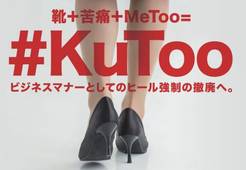04/2020: The World of Shoes
“Would you like to work for us? With an attractive poster, my favourite cake shop appeals to students who are looking for an hourly job. It shows a cute young lady, a pink hair band in her magnificent head of curled hair that, I dare say, not entirely by accident makes a bunny out of her. She turns with panache in her pink dress; even her high heels are in the company pink. “You need a confident manner and sure-footed approach” is one of the five requirements for being taken on.
Given her hazardously high heels, the “sure-footed” may not be meant literally. So why high heels, one wonders.
“High heels slow women down, thus giving the men more time to look at them,” French shoe designer Christian Louboutin is supposed to have said.
While I drink my hot chocolate with whipped cream – for me, nowhere does it taste so good as here – I observe the men present. They are looking rather at their newspapers than at the female staff. That may be due to the fact that the waitresses don’t subject their taxed feet to the demands of dizzying high heels, but sensibly resort to the tried and tested flat variety.
At least they have a choice.
https://medium.com/@unseenjapan/kutoo-a-revolt-against-high-heels-in-the-japanese-workplace-6228feb6d2d4
 |
It would be different in Japan. There, women in many companies suffer under strict dress regulations. Under the hashtag #KuToo (a play on words between the Japanese words kutsu (shoes) and kutsuu (pain)), more than 18,000 women signed a petition last June to fight back against the compulsion of high heels exerted by their employers. The Ministry of Health, Labour and Welfare blocked it: in some workplaces, they say, shoes with high heels (for women) are “necessary and appropriate”. But isolated successes give hope. Japan Airlines are now allowing their female staff to replace the high heels with foot-friendly attire. The three major mobile phone providers have also followed suit.
The compulsion to wear uncomfortable high heels is not the only dictate of Japanese employers. In fact, there is a glasses ban for women in some companies, for example, at reception. Women at the front desk are the “face of the company”, they say. Glasses get in the way. Some cosmetics companies also argue that glasses on their saleswomen mask the proprietary product. Those who cannot tolerate contact lenses simply walk blindly through the world.
There are dress codes in many companies worldwide, which is permissible in terms of a managerial prerogative to issue directives, but where are the limits? The Regional Labour Court of Cologne, for example, ruled that the colour of one’s nail polish was no business of the employer, but it can very well stipulate that employees “wear bras, bustiers or a vest”, and also prescribe the colour of their underwear, so that it does not show through.
One Swiss bank even demands “elegant artificial fingernails” from its female employees, but prohibits intrusive jewellery, as well as skirts that are too tight on the bum. Whether the heel height is limited to 7 cm due to health considerations or with a view to the ability of male colleagues to concentrate is not known.
https://www.stuttgarter-nachrichten.de/inhalt.prinz-charles-socken-gate-falsche-schublade.494e027c-b972-4efc-98df-b88e1f9ac75c.html
 |
Dress codes wish to send signals to their target groups; etiquette wishes to cement affiliations, attitudes, perhaps also demarcations. For example, brown men’s shoes were for a long time a no-go in British banking circles. “Never brown in town” was the rule. Columnist Nicholas Foulkes reported in the Financial Times of gentlemen in his circle of acquaintances who even when hunting only wore black shoes. Until Prince Charles, with his artfully aged brown shoes (allegedly black shoe polish on brown leather), then toppled the worldview.
Men spare themselves bloody toes and burning heels and instead wear a suit and tie to demonstrate their position. “Today’s type of politician is very strongly influenced by images due to the constant presence in the media”, ‘power expert’ Christine Bauer-Jelinek told ORF.at. She observes “the so-called slim-fit types in politics”: men with slender suits and shorter cut trousers, from beneath which gaily coloured socks then perhaps flash out. In addition, narrow-fit jackets. “They all look as if they are wearing the suits of their younger brothers”, says Bauer-Jelinek. These are deliberate signals sent out to target groups, she says.
“The strong embodiment of the political has created a new ideal type: the slim-fit warrior”, says youth researcher Bernhard Heinzlmaier. “They thereby symbolise the svelte, new, liberal, agile, highly individualised capitalism.”
Back to high heels. For the designer Louboutin, they stand for (female) strength: “High heels can artificially make a woman taller, but she still has to walk by herself. So, the real strength, she brings herself. An unstable woman does not put on high heels. She would be constantly going over.” No wonder, with the heel height of his creations of up to 12 centimetres. Summer Brennan, author of the book “High Heels” calls court shoes the “ties for women” in professional life.
A BBC report says: “If the high heel is a patriarchal tool designed to slow a woman down, the rise of the fashion trainer is the perfect rebuff.” Plimsolls have also long been permitted at almost all public and professional occasions. “It is perhaps no coincidence that the rise of the trainer has coincided with fourth-wave feminism...” writes the BBC. Even Christian Louboutin now has trainers in his range – and even in pink. €1092.50. A pair.
Now I’ve finished my hot chocolate. Before I pay and leave, I flick through the list of offers from my favourite cake shop: “Fashionable courts in pink made from the finest Belgian chocolate” can be crafted, weighing in at 250 grams, good for 6 months when kept refrigerated, heel height not specified, but impressive. Or the same in chocolate brown, called “Chocolate Shoe, Pearls”, and brown with pink dots (“Chocolate Shoe, Pink Dots”) is also possible.
I am not sure who the target group is: shoe fetishists or chocoholics?
All chocolate shoes: aida.at
 |
My previous ‘five finger exercises’ and newsletters can be read here. I’d be delighted if they were shared!
I post my five finger exercises every so often, whenever I have something to relate.
GDPR statement: I have not stored any data other than your name and email address. Please let me know via this link, if you no longer wish to receive mailings from me; I will then delete your data immediately.
|